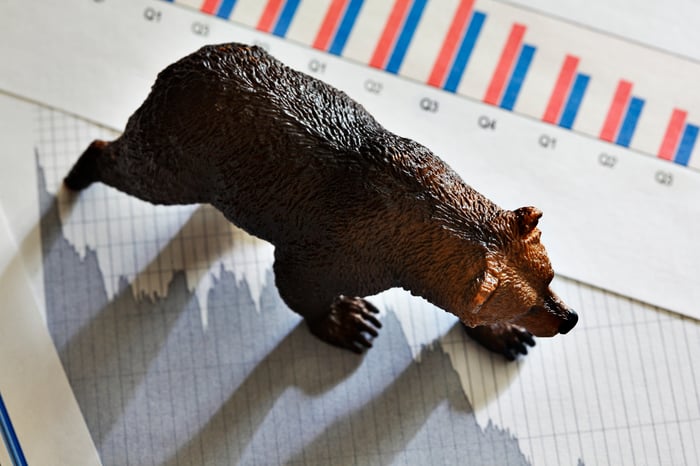As the clock ticks closer to the new year, investors can’t help but marvel at the impressive performance of Wall Street in 2023. The Dow Jones Industrial Average (DJINDICES: ^DJI) hit a historic high, with the benchmark S&P 500 (SNPINDEX: ^GSPC) and innovation-driven Nasdaq Composite (NASDAQINDEX: ^IXIC) posting gains of 25% and 44%, respectively, year to date as of Dec. 28.
However, the focus now shifts from where the stock market has been to where it’s headed next. While there is no crystal ball for perfect forecasting, investors rely on a mix of historical data, macro indicators, and experience to shape their predictions for the future.
Let’s delve into 10 predictions for the stock market in 2024, including macro forecasts that could influence equity performance.

Image source: Getty Images.
Anticipated Recession in the U.S. Economy
To start, 2024 is expected to mark the onset of the most anticipated recession in U.S. history. The Conference Board Leading Economic Index (LEI), which comprises 10 inputs to predict business cycle turning points, has seen 19 consecutive months of decline. This signal, unlike anything seen since the Great Depression, points to an impending economic slowdown.
Additionally, the decline in commercial bank credit since mid-February indicates a deliberate tightening of lending standards. Moreover, the M2 money supply is witnessing its first decline since the Great Depression, hinting at an impending economic slowdown.
Return of the Bear Market
While the U.S. economy and stock market are not directly correlated, a recession typically has an adverse impact on corporate earnings. Historically, around two-thirds of the S&P 500’s downturns have occurred post a recession, rather than before it. This indicates that a stock market bearish phase may follow if a recession materializes.
Moreover, the S&P 500’s Shiller price-to-earnings (P/E) ratio stood at 32.36 on Dec. 28, about 90% higher than its historical average. Such premium valuations over extended periods have historically foreshadowed market value declines.
End of Longest Yield-Curve Inversion
The prolonged inversion in the yield curve, with shorter-dated debt securities yielding more than longer-dated bonds, has historically signaled forthcoming economic and stock market trends. While the current inversion may set a record as the second-longest, an anticipated rate-easing cycle is likely to normalize the yield curve by the year-end.
Potential Growth in Disliked Industry
If the Treasury yield curve inversion ends in 2024, industries sensitive to interest rates could benefit. This includes one of Wall Street’s most universally disliked industries:
Insightful Projections on the Financial Landscape in 2024
Mortgage real estate investment trusts (REITs) such as Annaly Capital Management (NYSE: NLY) and AGNC Investment (NASDAQ: AGNC) have been challenged by the yield-curve inversion, which has narrowed their net interest margin and made short-term borrowing more expensive. However, with the potential end to this inversion and dovish Fed monetary policy, it’s possible that Annaly Capital Management and AGNC Investment could shine for income seekers.

Image source: Getty Images.
5. The Stubbornness of Core Inflation
While many investors may be excited about the Federal Reserve’s anticipation of three rate cuts in 2024, it’s important to consider the potential downside. In response to a growth slowdown, the Fed has historically cut rates, risking a reacceleration of inflation. With U.S. gross domestic product increasing by 5.2% in the third quarter and a planned reduction in rates, the core inflation rate, which excludes volatile food and energy costs, could remain stubbornly high. The housing market, impacted by higher mortgage rates, is unlikely to temper core inflation unless a severe economic downturn occurs, halting economic growth.
6. The Bursting of the Artificial Intelligence (AI) Bubble
Despite the widespread enthusiasm for artificial intelligence (AI), history suggests that every newly hyped investment trend experiences an initial bubble period. The potential bursting of the AI bubble could be driven by Nvidia (NASDAQ: NVDA), which has dominated the infrastructure of AI-accelerated data centers. However, as production expands and competition intensifies, Nvidia’s pricing power and gross margin may face negative consequences in the upcoming year.
7. Microsoft’s Ascension and Apple’s Stalled Growth
Apple (NASDAQ: AAPL), previously a top contender in the tech industry, has seen its growth engine stall with sales declines across its physical products in fiscal 2023. This stagnation has paved the way for Microsoft (NASDAQ: MSFT) to surpass Apple and become the most valuable public company. With significant contributions from its legacy operations and a strong foothold in the cloud infrastructure service sector, Microsoft has the potential to claim the top position in 2024.
8. An Introspection on Tesla’s Future
In line with the discussion of major companies, it is plausible that the world’s largest electric vehicle (EV) corporation, Tesla, could experience a substantial decline, potentially falling below $100 per share, as a noteworthy aspect of the financial landscape unfolding in 2024.
Market Insights for 2024: Tesla’s Decline, Utilities’ Revival, and Short-lived Crisis
In a world of enigmatic and unpredictable market shifts, some prognosticators have begun to speculate on the future of the financial landscape come 2024. One prominent prediction involves the fading fortunes of the darling of electric vehicles, Tesla, while another foretells the phoenix-like rise of the utility sector. And amidst this backdrop, whispers abound about an unforeseen event that could momentarily derail the reliability of Wall Street as we know it.
Tesla’s Troubles
The symbol of innovation, Tesla, faces an uncertain road ahead, with analysts prophesying that its market cap will dip below $100 per share in the coming year. This startling forecast arises as Tesla’s pricing strategy raises concerns. Repeated price cuts on its Model 3, S, X, and Y suggest a waning demand, a surge in inventory levels, and heightened competition. As a result, the once sky-high operating margin of Tesla is now walking hand in hand with the auto industry average.
Elon Musk, the enigmatic CEO, looms as a tangible risk for Tesla’s stakeholders, as he tends to fall short of his ambitious promises. While Tesla is renowned for its prowess in the energy and auto sectors, the bulk of its profit comes from selling and leasing EVs, tethering it to unsustainable sources of income. This fragility unnerves investors, portraying Tesla as an enterprise built on shaky ground.
A Flourishing Phoenix: Utilities in 2024
On the flip side, the utility sector, languishing as one of the lowest performers in the S&P 500 for 2023, is set to emerge as one of the top three sectors in the new year. Long favored for their low volatility, generous dividends, and consistent operational performance, utilities faced a bleak year as investors diverted their funds to Treasury bonds amidst rising Treasury yields. However, with the Federal Reserve signalling an easing of interest rates in 2024, utilities are poised for a resurrection. As Treasury bond yields taper, the allure of utility stocks with robust dividend yields will resurface. Simultaneously, access to cheaper borrowing rates could spur acquisitions and major projects, breathing life back into the fortunes of leading utility companies such as NextEra Energy.
Anticipating a Fleeting Crisis
Lastly, the crystal ball gazers predict the emergence of an unforeseen dilemma that may fleetingly hobble Wall Street. The annual tradition of a disruptive event wreaking havoc on the markets is expected to persist. Be it a housing price collapse or a wave of auto loan defaults, the exact nature of the crisis remains uncertain. However, experience teaches that such crises are transitory, serving as mere blips in the grand scheme of the financial world.
